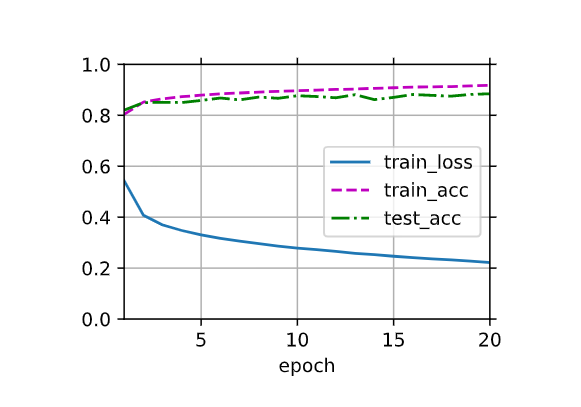导入数据
import torch
import torch.nn as nn
from torch.utils import data
import torchvision
from torchvision import transforms
import numpy as np
import pandas as pd
import matplotlib.pyplot as plt
import torch.nn.functional as F
from d2l import torch as d2l
%matplotlib inline
trans = transforms.ToTensor()
mnist_train = torchvision.datasets.FashionMNIST(root = './image_classification/data',train=True, transform=trans, download=True)
mnist_test = torchvision.datasets.FashionMNIST(root='./image_classification/data',train=False, transform=trans, download=True)
train_iter = data.DataLoader(mnist_train, batch_size=64, num_workers=4, shuffle=True)
test_iter = data.DataLoader(mnist_test, batch_size=64, num_workers=4, shuffle=True)
MLP
class Linear(nn.Module):
def __init__(self, indim, outdim):
super(Linear, self).__init__()
self.W = self.W = nn.Parameter(torch.FloatTensor(indim, outdim))
nn.init.xavier_normal_(self.W)
self.b = nn.Parameter(torch.FloatTensor(outdim))
nn.init.normal_(self.b,mean=0, std=0.01)
def forward(self, x):
return x @ self.W + self.b
class Net(nn.Module):
def __init__(self, indim, classes):
super(Net, self).__init__()
self.Lay1 = Linear(indim, 256)
self.Lay2 = Linear(256, 64)
self.Lay3 = Linear(64, classes)
def forward(self, x):
x = x.reshape(-1, 784)
x = self.Lay1(x)
h = F.tanh(x)
h = F.tanh(self.Lay2(h))
o = self.Lay3(h)
return F.log_softmax(o)
我这里使用了log_softmax,意味着我后面直接用nllLoss就行,而不用交叉熵损失函数。
定义准确度
def accuracy(y_hat, y):
y_hat = y_hat.argmax(dim=1)
cmp = (y_hat.type(y.dtype) == y)
return cmp.type(y.dtype).sum()
def evaluate(net, test_iter):
metrics = d2l.Accumulator(2)
for x, y in test_iter:
y_hat = net(x)
metrics.add(accuracy(y_hat, y), len(y))
return metrics[0] / metrics[1]
这个Accumulator是一个累加器,因为我们训练的时候都是一个batch一个batch进行训练,如果要获得一个epoch的训练误差或者说准确度,就需要定义这么一个累加器。因为test数据也是一个batch读取,所以我们也需要做一个累加器。
训练
indim = 784
classes = 10
net = Net(indim, classes)
loss = nn.NLLLoss(reduction='mean')
optimizer = torch.optim.SGD(net.parameters(), lr=0.1, weight_decay=5e-5)
def train(net, train_iter, test_iter, loss, optimizer, num_epochs):
animator = d2l.Animator(xlabel='epoch', xlim = [1, num_epochs], ylim=[0, 1],
legend=['train_loss', 'train_acc', 'test_acc'])
for i in range(num_epochs):
metrics = d2l.Accumulator(3) # 记录预测准确数、loss、以及size
for x, y in train_iter:
y_hat = net(x)
l = loss(y_hat, y)
optimizer.zero_grad()
l.backward()
optimizer.step()
metrics.add(accuracy(y_hat, y), float(l)*len(y), y.numel())
train_acc = metrics[0] / metrics[2]
train_loss = metrics[1] / metrics[2]
test_acc = evaluate(net, test_iter)
animator.add(i+1, (train_loss, train_acc, test_acc))
if i == num_epochs-1:
print("最终的train loss:{} train acc:{} test acc:{}".format(train_loss,train_acc, test_acc))
train(net, train_iter, test_iter, loss, optimizer, 20)
这里的Animator函数,看了很久也没看懂,就记着它的api调用方法吧。

预测
def predict_ch3(net, test_iter, n=6): #@save
"""预测标签(定义见第3章)。"""
for X, y in test_iter:
break
trues = d2l.get_fashion_mnist_labels(y)
preds = d2l.get_fashion_mnist_labels(net(X).argmax(axis=1))
titles = [true +'
' + pred for true, pred in zip(trues, preds)]
d2l.show_images(
X[0:n].reshape((n, 28, 28)), 1, n, titles=titles[0:n])
predict_ch3(net, test_iter)